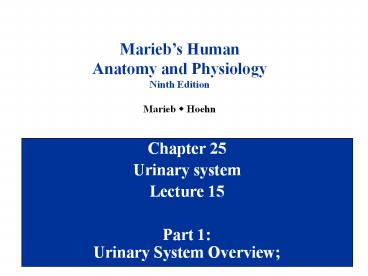Urinary system - PowerPoint PPT Presentation
Title:
Urinary system
Description:
Title: NVCC Bio 212 Subject: Urinary System Author: Greg Erianne Last modified by: Gregs Desktop Created Date: 1/14/2003 11:27:33 PM Document presentation format – PowerPoint PPT presentation
Number of Views:141
Avg rating:3.0/5.0
Title: Urinary system
1
Mariebs Human Anatomy and Physiology Ninth
Edition Marieb w Hoehn
- Chapter 25
- Urinary system
- Lecture 15
- Part 1 Urinary System Overview
2
Functions of the Kidneys
- Make urine
- Regulate blood volume and blood pressure
- Regulate plasma concentrations of Na, K, Cl-,
HCO3-, and other ions - Help to stabilize blood pH
- Conserve valuable nutrients
- Assist the liver in detoxification and deamination
3
Urinary System
Figure from Holes Human AP, 12th edition, 2010
Kidneys receive about 1.2 L of blood per minute
and filter nearly 180 L of fluid from the
bloodstream every day!
4
Location of Kidneys
Figure from Martini, Anatomy Physiology,
Prentice Hall, 2001
Located retroperitoneally from T12 to L3 Left
kidney is slightly higher than right
kidney Adrenal glands sit on the medial and
superior part of kidneys
Nephro(s) kidney
5
Location of Kidneys
Helps maintain position of kidney
Figure from Martini, Anatomy Physiology,
Prentice Hall, 2001
6
Gross Anatomy of the Kidneys
Renal capsule is tough, fibrous capsule (tunica
fibrosa) Hilus is entry point for renal artery,
vein, and nerve (mostly sympathetic fibers) Bases
of renal pyramids face the cortex, apices face
the renal pelvis and end at renal papillae
Pyel(o)-
Figure from Martini, Anatomy Physiology,
Prentice Hall, 2001
7
Renal Blood Vessels
Glomeruli
(Cortical radiate arteries)
Minor Calyx
Figures from Martini, Anatomy Physiology,
Prentice Hall, 2001
Nerves, mainly sympathetic postganglionic fibers
of the ANS, follow arteries to nephrons
8
The Nephron
(80)
(20)
Nephrons are the structural and functional units
of the kidney
Figure from Holes Human AP, 12th edition, 2010
9
Blood Supply of the Nephron
The capillary loop of the vasa recta is a type of
capillary that is closely associated with the
nephron loop of juxtamedullary nephrons
Medulla
Figure from Holes Human AP, 12th edition, 2010
10
Blood Flow Through Kidney and Nephron
Know this!
Figure from Holes Human AP, 12th edition, 2010
11
Renal Corpuscle (Glomerulus Capsule)
Figure from Holes Human AP, 12th edition, 2010
Notice that the efferent arteriole is smaller
than the afferent arteriole This creates a high
pressure (55-60 mm Hg) in the glomerular
capillary bed
(Bowmans)
Filtrate in capsular space
12
Visceral Glomerular Epithelium
Figure from Holes Human AP, 12th edition, 2010
Material passing out of the blood must be small
enough to fit through the filtration slits (slit
pores)
13
Renal Cortex and Renal Medulla
Figure from Holes Human AP, 12th edition, 2010































